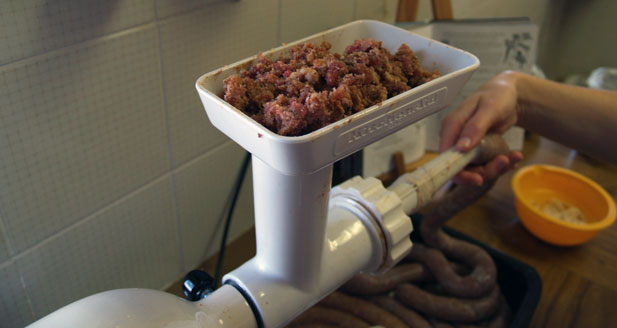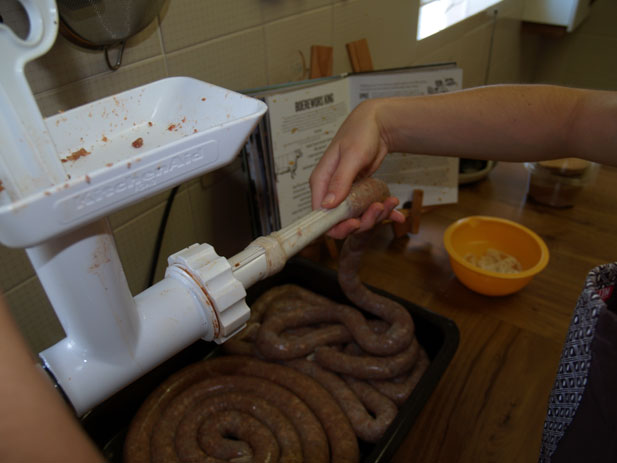How to make boerewors from scratch
 It was not difficult to choose a recipe to test. Just imagining the look on my father’s face when I arrived at his house with homemade wors was enough to make me want to try it. Although making boerewors sounds quite daunting, the recipe holds your hand throughout the process. I would not recommend making boerewors for a weeknight meal, but as a weekend project, it was fun and much less difficult and time-consuming than I thought it would be. The best part of the process (other than eating delicious boerewors) was getting to know my butcher. He even offered to grind the meat and stuff it into the sausage casing using his machinery when it was done marinating! Everyone who was lucky enough to eat the wors agreed that it was very tasty. Next time, I would leave the breadcrumbs out because I think they made the texture more like normal sausage and less like boerewors.
It was not difficult to choose a recipe to test. Just imagining the look on my father’s face when I arrived at his house with homemade wors was enough to make me want to try it. Although making boerewors sounds quite daunting, the recipe holds your hand throughout the process. I would not recommend making boerewors for a weeknight meal, but as a weekend project, it was fun and much less difficult and time-consuming than I thought it would be. The best part of the process (other than eating delicious boerewors) was getting to know my butcher. He even offered to grind the meat and stuff it into the sausage casing using his machinery when it was done marinating! Everyone who was lucky enough to eat the wors agreed that it was very tasty. Next time, I would leave the breadcrumbs out because I think they made the texture more like normal sausage and less like boerewors.
 Ingredients (to make about 3.5kg of boerie)
Ingredients (to make about 3.5kg of boerie)
1kg beef, 1kg veal or lean pork, 1kg mutton
500g bacon
a couple of good pinches of crushed salt
ground black pepper
a small handful of coriander seeds, roasted and crushed
a small pinch of ground cloves
a small pinch of ground nutmeg
about 1/4 cup red wine vinegar or red wine
5-6 cloves of garlic, crushed and minced
a good pinch of fresh thyme, chopped finely
a pinch of mustard seeds
6 cups of toasted breadcrumbs
5 metres of sausage casings (that fit your sausage funnel)
Spice
Add the spices and the vinegar or wine to the sliced meat and allow it to marinate in the fridge before mincing, ideally overnight. This will ensure that the spices are evenly distributed when you grind the meat.
Mince
You can get your butcher to do this for you, the the old school way is with a mincer (which means you can control how chunky the sausage is). Be sure that the meat has been in the fridge for an hour or two before mincing; cold meat is likely to be minced rather than mashed. For less chunky sausauge, run it through the mincer twice.
[NB: make sure your mincing machine, hands and work surface are clean and once you’ve minced your meat, cook up a little taster to check that you’re happy with the amount of seasoning and that it is not too dry. Once the meat is in the casing you won’t be able to change the flavour or add juiciness].
Stuffing (you can use a sausage funnel (or stuffing horn) or an electric mincer with attachment)
1. Flush the sausage casing by rinsing it in warm water three times and then running water through it. This helps to clean the sausage casing out and makes it easier to roll it on to the sausage funnel. Once rinsed, measure out metre-long lengths of sausage casing, cut them, and place them in a bowl of warm water.
2. Next, find the end of a casing and slip it over the end of your mincing funnel. Slide the casing over the funnel and leave a little casing hanging over the edge (because you’ll need to tie a knot).
 3. Put your mince in the top of your mincer or funnel and switch on (or start cranking if you are using a manual machine). The corkscrew device in the mincer forces the mince through the funnel into the casing.
3. Put your mince in the top of your mincer or funnel and switch on (or start cranking if you are using a manual machine). The corkscrew device in the mincer forces the mince through the funnel into the casing.
 4. When the mince starts coming out of the funnel, ease the casing off the funnel at the same speed as the mince comes out. You should end up holding a nice sausage in your hand (regulate the amount of mince going into the casing by pinching the casing with your thumb and forefinger).
4. When the mince starts coming out of the funnel, ease the casing off the funnel at the same speed as the mince comes out. You should end up holding a nice sausage in your hand (regulate the amount of mince going into the casing by pinching the casing with your thumb and forefinger).
[TIP: Increasing or decreasing finger pressure on the casing will determine how tightly and consistently the sausage is stuffed. If the casing bursts, tie it off and start again.]
5. When you are done, you can either twist off sausages into lengths, or, as in the case of traditional boerie, leave it as one sausage.
6. Refrigerate until the casings are dry, this helps the flavours to develop.
 Download print-friendly recipe
Download print-friendly recipe
Read a review of Justin Bonello Cooks… for friends
See more books from Justin Bonello
